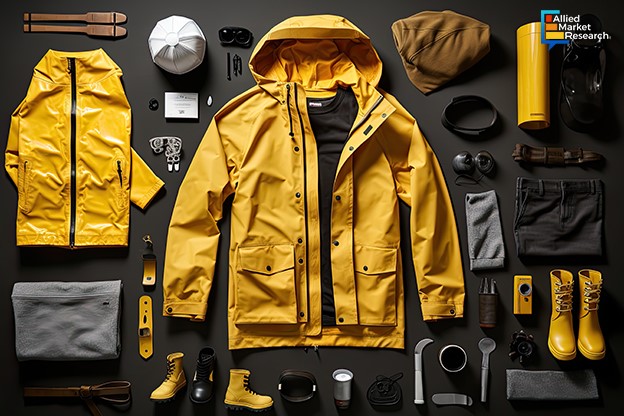Which Trending Types of Functional Apparel Can Empower Your Business with Wide Possibilities?

14 Feb
2024
Highlights:
- Introduction
- Popular types of functional apparel
- Use of sustainable fabrics
- Some promising acquisitions in the sector
Being one of the oldest industries in the world, the textile industry has continuously embraced the latest technological advancements to offer comfort and convenience to users. Functional textiles or apparel is one of the most demanding branches of technical textiles that use different types of fabrics to satisfy the need for functionality and adaptivity to certain conditions. Previously, the main motive for designing such products was to meet the requirements of certain end-use applications. However, today, textile manufacturers are emphasizing fabric design to offer an aesthetic look and appearance as well. Furthermore, they also consider some important properties while manufacturing these textiles, including flexibility, compatibility, and interactivity. In this article, we will talk about various types of functional apparel benefiting several industries.
Which type of functional apparel is driving the textile industry?
Nowadays, individuals have undergone significant lifestyle changes to remain fit. The rising awareness of health consciousness and wellness has inclined individuals toward participating in various sports and wellness activities such as yoga, swimming, exercising, and many more. These factors have pushed the demand for sportswear functional clothing to provide comfort and ease to individuals while performing such activities. Here comes the role of smart textiles that goes beyond regular textiles. Sportswear is manufactured to support athletes and fitness-loving individuals to enhance their performance. While designing such apparel manufacturers focus on implementing functional properties such as temperature regulation, lightweight properties, moisture management, odor reduction, and more. Such features in sportswear can offer a higher comfort level to individuals while performing multiple fitness-related activities. Because of the increasing number of sports-loving crowds, the sportswear segment is predicted to lead the trail and is predicted to generate a revenue of $81,022 million revenue during 2023-2032.
Another popular type of functional clothing is protective clothing. This type of clothing is very crucial for users as it can make the difference between life and death. This type of clothing is beneficial for performing a wide range of critical applications such as protection from natural hazards, protection from chemical, biological, and radiation hazards, and protection from injuries. Such types of functional clothing are manufactured using specific types of materials depending on the purpose of use. For example, firefighters usually wear clothing made from a combination of materials such as Kevlar, Nomex, and other flame-resistant synthetic fibers as these materials possess high flame and heat resistance. For these types of clothing, polyester, and cotton-like materials cannot be used as they lack flammability resistance. Other examples of protective clothing include space suits, chemical-resistant gloves, hazmat suits, bulletproof vests, respirator masks, and more.
What latest fabric materials can lead the functional apparel industry toward sustainability?
The growing global concern toward environmental issues has made several industries adopt sustainable practices. Moreover, the rising awareness among consumers about the importance of using biodegradable materials and the emerging climatic change and its challenges have made clothing manufacturers use sustainable fabrics. These days, plant-based leather has gained huge popularity in the textile industry. For example, Pinatex, a fiber derived from pineapple leaves, can be used for the development of various types of functional apparel. The production of Pinatex requires less water than cotton and avoids the use of harmful chemicals.
According to a recent survey, many natural fibers have revealed serious drawbacks in the modern era. Even cotton as the best natural fiber has shown its issues. When these fibers are washed, they release microfibers that end up polluting water and rivers. Lyocell, commercially known as Tencel, has come out as an ideal natural fiber that does not release microfibers. The material is derived from wood pulp and is easily compostable and biodegradable.
Moreover, bamboo, cork, and hemp are environmentally friendly natural fibers that can be widely used for activewear due to their high breathability and moisture-wicking capabilities. These fibers can also offer anti-microbial properties that help reduce odors and contamination in functional apparel. Along with all these advantages, these fibers can serve as vegan alternatives for those committed to an animal-free lifestyle.
Competitive moves of top players in the domain
The functional apparel industry is experiencing remarkable growth due to the growing demand for comfortable and protective wear in various environments. Many leading players in the domain have made profitable alliances to stay ahead in the competitive landscape. For example, Coats Group plc, a leading industrial thread manufacturer announced its acquisition of Texon, a renowned provider of premium structural components and materials for the footwear, accessories, and apparel industries. With this acquisition, Texon would strengthen its presence in the highly attractive athleisure footwear industry.
Another instance is the acquisition of Rainbow West Apparel, a woman and minority-owned swimwear company by Hop Lun, a leading manufacturer of swimwear. This acquisition would benefit Rainbow West Apparel to expand its design capabilities and offer more flexibility and comfort to its customers.
To conclude, the increasing demand for functional clothing among the working population will prominently drive the growth of the sector in the coming years. Moreover, the growing advancements in fabric technology will lead to offering more innovative and comfortable functional apparel in the future.
To get more insights into the functional apparel industry and identify potential investment opportunities across various regions, feel free to talk to our experts today!

Rosy Behera
Author's Bio- Rosy Behera holds a bachelor’s degree in Electrical and Electronics Engineering and now she is a content writer by profession. She loves to portray her thoughts and ideas with a nice command of words. Grabbing an audience with her creative write-ups is one of her biggest assets so far. Apart from writing, she is a certified “Odisi” dancer and has done Gardharva in Drawing, Painting, and Arts. She always explores new things through travel and is a big foodie.
Avenue: Entire Library membership of Allied Market Research Reports at your disposal
- Avenue is an innovative subscription-based online report database.
- Avail an online access to the entire library of syndicated reports on more than 2,000 niche industries and company profiles on more than 12,000 firms across 11 domains.
- A cost-effective model tailored for entrepreneurs, investors, and students & researchers at universities.
- Request customizations, suggest new reports, and avail analyst support as per your requirements.
- Get an access to the library of reports at any time from any device and anywhere.
Related Post
-
How are Submarine Cables Transforming Global Connectivity with Enhanced User Experience?
-
Endoscopy Procedures: Transformations in Techniques and Applications
-
AI-Powered Video Analytics: How the Product Actually Works for enterprises
-
Painting Robots: Transforming Precision Coating and Creative Applications
-
Innovations in Pharmacovigilance Systems Advancing Patient Safety
-
Understanding Edge Security: Keeping Data Safe Near the Source
-
Exploring the Use and Advancements of 3D Laser Scanners in Professional Applications
-
Reinforcing Industrial Controls with Smarter Tools and Training








